Welcome to the second post in our Digital Health Foundations series! In case you missed it, be sure to have a look at the first post – Introducing “Digital Health Foundations” – A Retrospective on the Last Decade in Digital Health. Over the next several days, I’ll be publishing excerpts from the upcoming HealthQuant white paper entitled, “Digital Health Foundations: How the science of digital health in the 2010s is shaping the 2020s and beyond.” If you’d like to be notified via email when the full report launches, you can notify us here.
Today’s post includes our topical analysis of Digital Health publications over the last decade; upcoming posts will focus on our study of the individuals & institutions who are most responsible for driving influential research in digital health over the last decade, and our look at the online influencers who have been most effective in evangelizing digital health.
Digital Health Topics Over Time
In a rapidly evolving space, it’s no surprise that the lexicon we use to describe it is changing too. In 2010, eHealth was all the rage – 77% of the papers published that year used that reference – and advanced concepts like Digital Medicine, Digital Therapeutics and references to clinical trials barely existed. Yet, as the chart below makes clear, eHealth has largely fallen out of favor as a descriptor – largely replaced by Digital Health as a generic umbrella term.
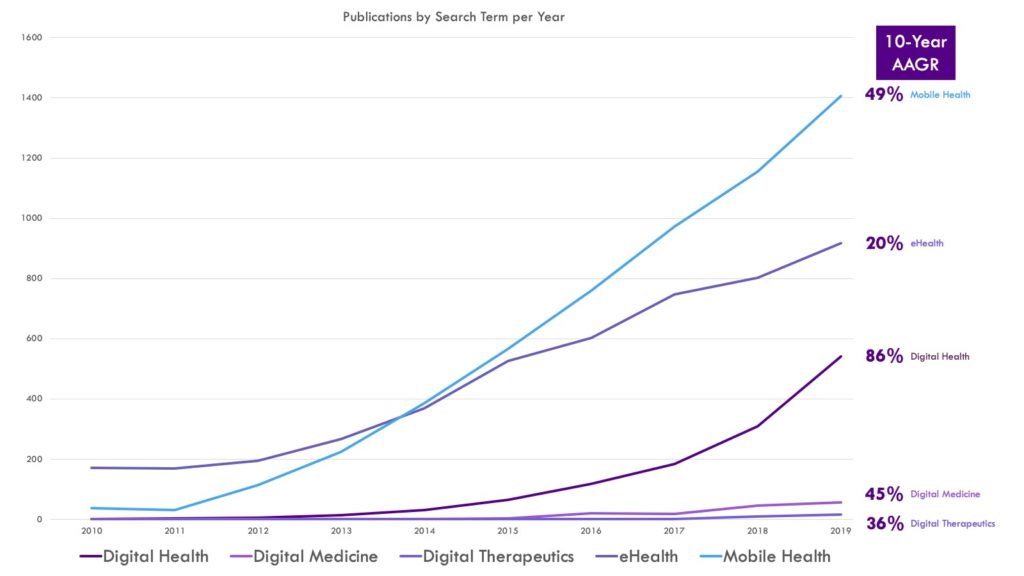
The advances in mobile technology – and the ubiquity of smartphones – are the real story here. When the last decade began, the iPhone was in its 3rd full year of mass availability, and “only” sold 40 million units – a far cry from the 200+ million units it’s sold every year since 2015. Given those factors, it shouldn’t be much of a surprise that the growth of Mobile Health as an area of focus has been so dramatic – with the number of Mobile Health publications increasing by more than 50% every year of the decade on average.
While eHealth was clearly the “catch-all” category in 2010, it has been largely replaced in that capacity with “Digital Health.” In fact, in 2019, 17% of the papers published in other categories also referenced “Digital Health” in their title or abstract, and usage of the term has been increasing an average of 86% per year over the last decade! Based on the chart above, it would be easy to dismiss “Digital Medicine” and “Digital Therapeutics” as meaningful categories – but I believe that to dismiss them would be a mistake. While only 2 publications used the term “Digital Medicine” in 2010, the term has grown an average of 45% per year since then. No publications mentioned “Digital Therapeutics” until 2015, but since then it’s grown an average of 36% per year.
It’s also worth noting that there have been meaningful, recent efforts to define these previously amorphous terms. In November of 2019, the Digital Therapeutics Alliance published its Digital Health Industry Categorization. According to the alliance, the following distinctions are made between Digital Health, Digital Medicine and Digital Therapeutics:
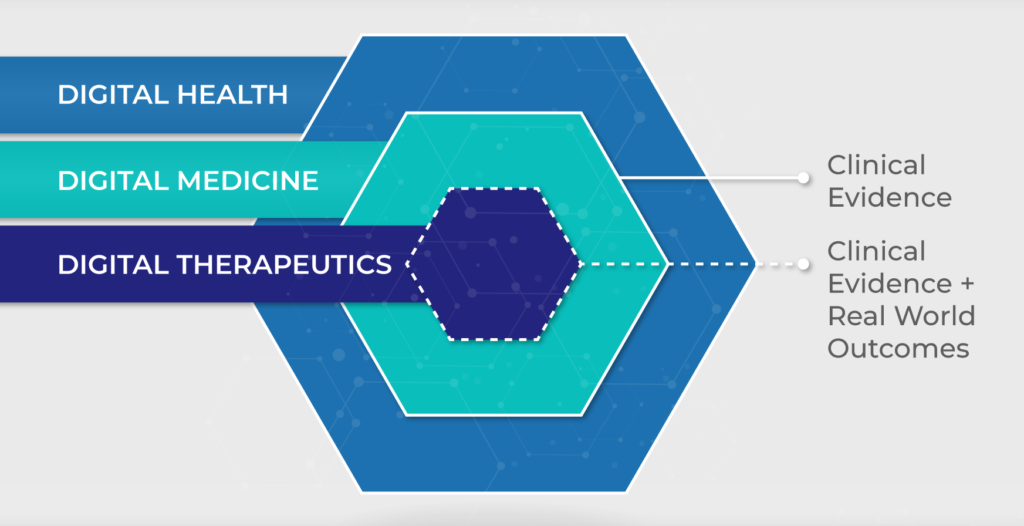
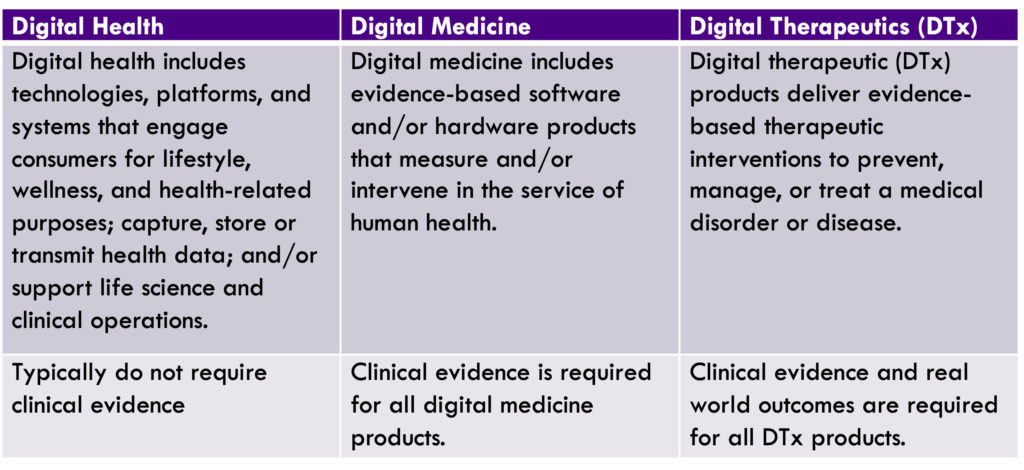
If these definitions take hold (which seems likely), I think we can count on seeing scientific publications referencing Digital Medicine and Digital Therapeutics to continue increasing significantly.
Going Beyond our Key Search Terms
While the relationship between our key search terms (Digital Health, Digital Medicine, Digital Therapeutics, Mobile Health and eHealth) is relatively clear, there are still a LOT of topics that came out under those broad queries. In fact, in the last decade we were able to discern 161 distinct topics that we were able to roll up into 12 broad categories:
- All eHealth (including web 2.0, web-based interventions, etc.)
- All Digital Health (including social media & digital social networks)
- All Digital Therapeutics
- All Digital Medicine
- All Mobile Health (including mHealth, mobile applications, text messaging, etc.)
- All Telehealth (including telemedicine, remote monitoring & sensing)
- All Social Determinants of Health (SDOH; including health equity, health disparities, access to care, etc.)
- All Health Behaviors/Empowerment
- All Health Behaviors/Adherence
- All Mental Health
- All Clinical Trials
- All Data/Analytics (including AI, Blockchain, etc.)
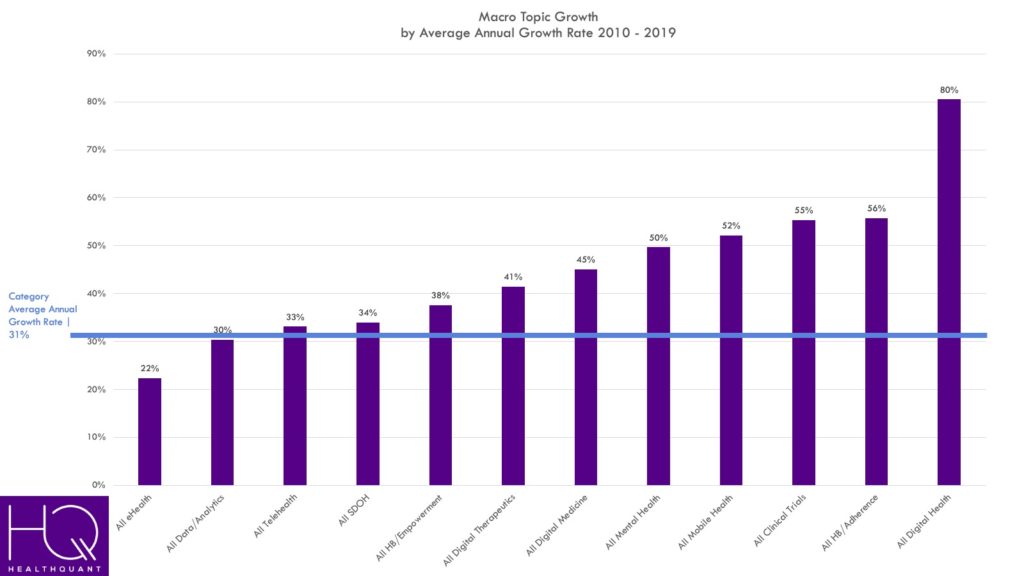
The trajectories for these categories (with the exception of the aforementioned eHealth) is trending at or above the average annual rate of increase for the entire category (31% growth per year).
It’s when we start diving inside those categories that some really interesting trends emerge, however. For example:
- There are 22 separate categories inside Mental Health, including some that are experiencing rapid growth in interest, e.g., Stress (68% average annual growth); Mindfulness (68% average annual growth) and Well-Being (55% average annual growth) and
- Digital health is becoming an important mechanism for helping manage health behaviors like Adherence to treatment (63% average annual growth)
- Understandably, reference to digital health in clinical trials has increased radically (Randomized Controlled Trial” has increased an average of 85% per year.
- And the king of all the high-growth categories is “Mobile Apps,” which has grown an average of 103% every year since formally entering the scientific world with 1 publication in 2011.
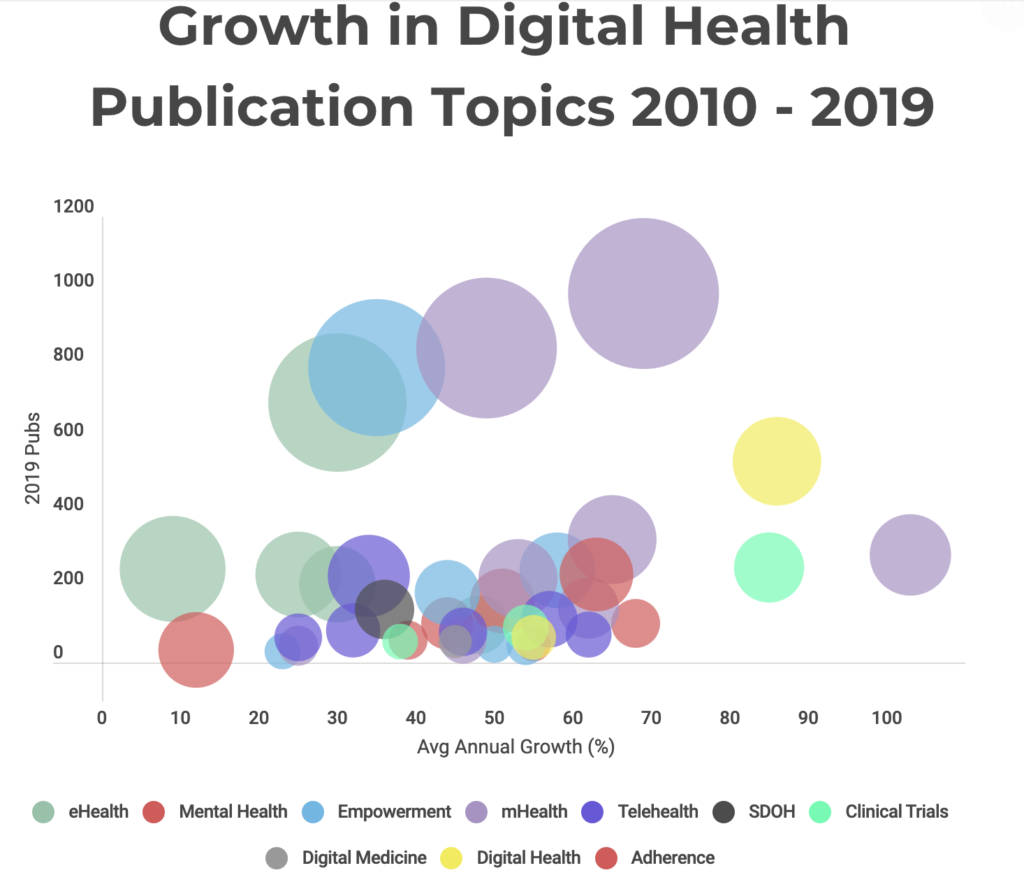
Don’t forget to stay tuned for upcoming posts, as we dive into our study of the individuals & institutions who are most responsible for driving influential research in digital health over the last decade, and our look at the online influencers who have been most effective in evangelizing digital health.
If you’d like to be notified via email when the full report launches, you can notify us here.
Leave a Reply